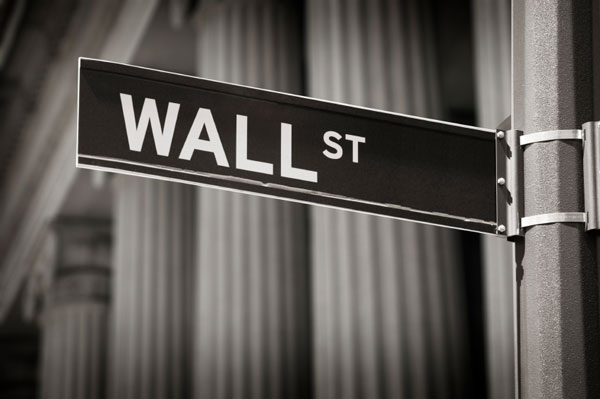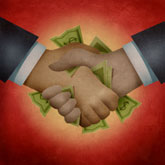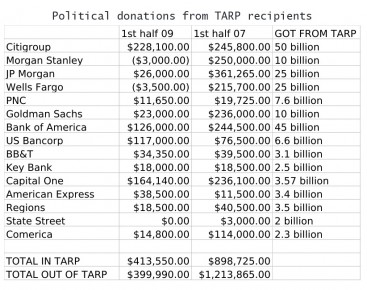Banking PACs’ Erratic Campaign Giving Signals Uncertainty
One watchdog says the strange giving patterns just shows the financial industry isn’t sure what’s happening to itself.
Jul 31, 202040.3K Shares1.6M Views
Even as Congress moves to put more curbs on Wall Street excesses, the nation’s top banks are writing fewer of the campaign checks that once won them lawmakers’ attention – a sign of uncertainty in the financial industry over how large a role it should play in politics in the near future.
The top 15 beneficiaries of the TARP bailout gave $813,540 from their political action committees (PACs) to congressional candidates and party committees during the first half of 2009, according to a Washington Independent analysis of campaign finance reports filed with the Federal Election Commission (FEC). During the same period in 2007, those 15 bank PACs donated $2.1 million.
Image by: Matt Mahurin
And despite the “stress tests” that began gauging banks’ health in the winter, those that won freedom from government control did not resume their formerly torrid pace of PAC activity in the second quarter of the year. Bank PACs still tied to TARP have given 54 percent less this year than in than in the last election cycle, while bank PACs freed fromthe bailout have seen a 67 percent drop.
Goldman Sachs provides a dramatic example of the trend. Just two days before giving taxpayers a 23 percent profitas it repaid government bailout aid, Goldman quietly reported its political contributions for the first half of the year: $23,000, a 90 percent drop from the same period in the last election cycle.
“The erratic pattern we’re seeing suggests that the financial industry isn’t sure what’s happening to itself,” said Craig Holman, legislative representative for Public Citizen’s Congress Watch. “Different banks and different bankers just see uncertain futures, and so they’re not sure if things are improving, not sure if they should be playing a big role in politics right now.”
That uncertainty marks a stark departure from the halcyon days of early 2007, when JP Morgan Chase was staking a claimto record revenues and pouring $361,000 in PAC donations into Capitol coffers. So far this year, the bank has repaid $25 billion to the Treasury – and given just $26,000 from its PAC.
Morgan Stanley experienced the harshest drought of all. After dishing out $250,000 in early 2007, including large checks to House Financial Services Committee Chairman Barney Frank (D-Mass.) and the pro-business Blue Dog Democrats, the bank’s only PAC activity this year has been three voided checks, totaling negative $3,000.
Citigroup and Comerica, by contrast, have increased their PAC giving in the first half of 2009 even while holding onto their bailout money. Such unpredictable campaign finance decision-making, a de facto ‘every bank for itself’ approach, made sense to Center for Responsive Politics (CRP) spokesman Dave Levinthal.
“Every entity has to make its own decisions and balance them between what it perceives to be the need to lobby and what it sees as the probable consequences,” Levinthal said.
He pointed to CRP’s top 10PAC spenders for this year, which includes four unions – a constituency most Democrats have no qualms about courting – but also the American Bankers Association (ABA), the trade group that often speaks for many of the same bailout recipients whose PACs are presently running dry.
In fact, several Democratic lawmakers who have forsworn donationsfrom bailed-out bank PACs, such as Frank, Rep. Ed Perlmutter (D-Colo.), and Rep. John Campbell (R-Calif.) appear to make an exception for the PAC of the ABA. Its donations have risen 19 percent between early 2007 and early 2009.
“It may be that [Democrats] don’t want [banks’] money,” said Robert Stern, president of the nonpartisan Center for Governmental Studies. “It may be that most congressmen are saying, ‘not now, guys’.”
Exhibit A in Stern’s theory may well be Senate Banking Committee Chairman Chris Dodd (D-Conn.), whose strugglesto dissociate himself from the industry he regulates were renewed last week after testimony suggestedthat he knew benefits were in the offing from Countrywide’s “VIP” mortgage program.
Dodd’s PAC received $2,000 from Goldman Sachs in January, before the senator vowed to stop taking donations from the PACs of bailed-out banks.
And lawmakers are not alone in fearing a public and media backlash from Wall Street campaign contributions. Individual bank employees donated 97 percent less in the first quarter of this year than in the same period in the 2008 election cycle, as the Independent reportedin April.
“The last thing I want to do is wake up one morning and see our PAC check being burned on C-SPAN,” one wary bank lobbyist told Newsweekin the spring.
The sharpest declines in PAC giving, however, did not occur at banks with the gravest public relations problems. Citigroup gave more in donations even as its CEO was facing accusations of lying to Congress, while JP Morgan was giving less despite its CEO’s cozy relationshipswith senior Democrats.
The 15 banks examined by the Independent for its analysis come from the Treasury Department’s monthly lending surveyof the top 20 TARP recipients. Six banks were excluded due to lack of PAC participation or sufficient FEC data.
If these banks are retreating to their political corners, then – becoming “fiefdoms” instead of one “monolithic” industry, in the words of Campaign Legal Center policy director Meredith McGehee – what happens when the economy recovers? Will the capital once again see spendthrift banks shower lawmakers with cash?
“Come September, I think we’ll be in a more traditional pattern,” McGehee said. “If you want anything done by next year, and you don’t start working on it now, you’re behind the eight ball.”
Stern also predicted resurgence in bank PAC activity by the end of this year, while Columbia Law School professor Richard Briffault suggested that donations could remain low for the rest of the 2010 election season thanks to Democrats’ broad advantage in national polling.
“In 2006 and 2008,” Briffault said, contributions rose because “those were very dramatic years. There was a lot of fighting for control of Congress.”
Three factors likely to push bailed-out banks back into PAC giving this fall come in the form of existing legislation. Frank plans to take up the Obama administration’s proposal for a consumer financial products safety commission in September, a bill beefing upshareholders’ role in executive compensation is on track for Senate action in the fall, and overall financial regulatory changes could come to a final vote before 2010.
Indeed, McGehee observed a climate of brewing interest among Washington interest groups of all sizes. “This conversation is happening in every room around town: ‘How do we get our thing done between now and Memorial Day?’” she said.
“That’s not necessarily a good thing for the American people.”

Hajra Shannon
Reviewer
Latest Articles
Popular Articles


